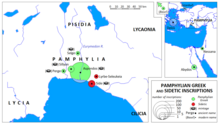Pamphylian Greek
| Pamphylian Greek | |
|---|---|
| Region | Pamphylia |
| Era | unknown |
Indo-European
| |
| Language codes | |
| ISO 639-3 | – |
grc-pam | |
| Glottolog | None |
Pamphylianwas a little-attested dialect ofAncient Greekthat was spoken inPamphylia,on the southern coast ofAsia Minor.Its origins and relation to other Greek dialects are uncertain, though a number of scholars have proposedisoglosseswithArcadocypriot.It is the soleclassical eradialect which did not usearticles,suggesting that it split off from other dialects early. Some of its distinctive characteristics reflect potentiallanguage contactwithAnatolian languagesspoken nearby.
Text corpus[edit]

Pamphylian is known from about 300 inscriptions,[1]most of them from the Pamphylian city ofAspendos.Nearly all of them are short and funeral and consist of names only. Pamphyliangraffitigiving single names have also been found abroad, in Egypt (Abydos) andDelos.The longest inscription is a 36 line decree from Aspendos, first analyzed in detail in 1880 byWilliam M. Ramsay.[2]Inscriptions are dated from the fifth century BCE to the Roman period, most of them being from the second century BCE.
Coins issued by Pamphylian cities also bear the script. Some 30 Pamphylian single words are known fromglossesgiven byHesychius,Eustathius,and theEtymologicum Magnum.
Pronunciation and writing[edit]

Pamphylia had a variantlocal Alpha bet,which was probably borrowed from other Greek Alpha bets. According to Selvi & Santamaria (2023) the Pamphylian Alpha bet stems from the 'dark blue' Alpha bets of North Eastern Peloponnese.[3]
| Sign | Α | Β | Δ | Ε | F | Η | Θ | Ι | ΙΙ | Κ | Λ | Μ | Ο | Π | Ρ | Σ | Τ | Υ | Φ | + | Ω | ||||||
| Greek equivalent | Α | Β | Γ | Δ | Ε, Η | (Ϝ) | Ζ | ῾ (Η) | Θ | Ι | Ι | Κ | Λ | Μ | Ν | Ξ | Ο, Ω | Π | Ρ | Σ | Τ | Υ | Φ | Χ | Ω | Ϝ | Ͳ |
| Transliteration | α | β | γ | δ | ε, |
ϝ | ζ | h (η) | θ | ι | ιι | κ | λ | μ | ν | ξ | ο, ō | π | ρ | σ | τ | υ | φ | χ | ω | и | ͳ |
| IPAsound | /a/ | /b/ | /g/ | /d/ | /e/,/ɛ:/ | /v/ | /sd/? | /h/ (/ɛ:/) |
/tʰ/ | /i/, /j/ | /i:ʲ/ | /k/ | /l/ | /m/ | /n/ | /ks/ | /o/, /ɔ:/ | /p/ | /r/ | /s/ | /t/ | /y/ | /pʰ/ | /kʰ/ | /ɔ:/ | /w/ | /ss/? |
The Pamphylian Alpha bet made use both of the originalPamphylian digamma(Ͷ) and a standarddigamma(Ϝ). It has been surmised that the original sound/w/in some environments (after vowels) was represented by Ͷ; where the sound had changed to labiodental/v/in the Pamphylian dialect, it was represented by Ϝ. Sometimes Ͷ also stood in the place ofbeta.It was found by Selvi & Santamaria (2023) that the Pamphylian Alpha bet originated from a process of selection, adaptation, and refunctionalization of a Northeast Peloponnesian model. This region, closely linked to Pamphylia by mythological and historical ties, used dark blue Alpha bets from Corinth to Argos, influenced by other Peloponnesian centers like Sparta. The use of <Ͷ> declined in the 4th century but persisted until the end of the Hellenistic period for sociocultural reasons. The Northeast Peloponnesian corpus doctrinae, encompassing the Alpha bets of the region, already had features of the Pamphylian Alpha bet. <Ϝ> represented the posterior approximant, and <Ͷ> was linked to the letter for /b/ in Corinth, possibly also representing /w/. When this system reached Anatolia, it became the Pamphylian Alpha bet through interaction with Anatolian Alpha bets and the phonetic changes in the Pamphylian dialect. This resulted in the variable use of <Ͷ>, <Ϝ>, and <B> during both Classical and Hellenistic periods, leading to their overlapping phonetic values.[4]

There is also a psi-likesampi(![]() ), used probably to represent the sounds/s/,/ss/,or/ps/.
[5]
), used probably to represent the sounds/s/,/ss/,or/ps/.
[5]
A conspicuous element in Pamphylian texts are doubleiotas,where the first iota denotes an /i/-sound and the second aglide/j/.
The Η sign usually represents a /h/-sound (rough breathing); only rarely, in a few late inscriptions, it is apparently used to represent the classical Greeketavowel (/ɛ:/ or /i:/).
Eustathius, quotingHeraclides,says that the Pamphylians "liked the /b/-sound so much that they often put b's in"; for example, instead ofaëlios('Sun'), they saidbabelios.And theEtymologicum Magnumsays that they tended to swallow /s/-sounds and pronounce them as a 'hairy' (δασύς) sound, i.e., a rough breathing: instead ofmousikathey saidmōˁika.[6](One may compare a similar phenomenon in theAnatolian languages,where, for example,Milyanmasa,'god', is an older counterpart ofLycianmaha.)
An inscription fromPergedated to around 400 BC reads:Ͷανά![]() αι Πρειίαι Κλεμύτας Λϝαράμυ Ͷασιρϝο̄τας ἀνέθε̄κε(Wanassāi Preiiāi Klemutas Lvaramu Wasirvōtas anethēke,'Klemutas the wasirvotas, son of Lvaramus, dedicated this to the Queen of Perge').[7]
αι Πρειίαι Κλεμύτας Λϝαράμυ Ͷασιρϝο̄τας ἀνέθε̄κε(Wanassāi Preiiāi Klemutas Lvaramu Wasirvōtas anethēke,'Klemutas the wasirvotas, son of Lvaramus, dedicated this to the Queen of Perge').[7]
In eastern Pamphylia, the Pamphylian citiesSideandLyrbe-Seleukiaused another language and script, calledSidetic.
Relation with the Anatolian languages[edit]
Pamphylic Greek appears to have been heavily influenced by nearbyAnatolian languagessuch asLycian,Pisidian,andSidetic,in bothphonologyandsyntax.Inmorphologyandlexicon,Anatolian influence apparently was much more limited.[8]
The phonological influence of Anatolian on Pamphylic has been characterized as "massive structural interference", affecting both the consonant and vowel repertoire.[9]Aspiratesgave way tofricatives,as didstop consonants.
In syntax three specific peculiarities stand out: absence of the article "the", use of thedativewith pre- and postpositions where other Greeks would use agenitive,and the use of a special expression και νι +imperative.
All of these features can be explained as an adaption of the Greek language by imperfect second-language speakers: if a small group of colonizing Greek immigrants remained a minority in an area inhabited by Anatolian speaking people, the heavily accented Greek spoken as a second language by the local population, coloured by their native Anatolian language, would become the norm in the area. Because Pamphylia was an isolated region ( "a backwater, relatively inaccessible" ), there were few external stimuli to later change this situation.[10]
Glossary[edit]
The following lexicon was extracted from the workA Greek–English Lexicon:[11]
- ἀβελιακόν/abeliakon– 'solar' (Attic:ἡλιακόν,heliakon)
- Ἀβώβας/Abôbas–Adonis(Attic:ὁ Ἄδωνις)
- ἄγεθλα/agethla– 'sacrificial victims' (Attic: 'the driven ones')
- ἀγός/agos– 'priest' (Attic:hiereus,Cf.agô lead)
- ἀδρί/adri(Attic:ἀνδρί,andri,dativeofanermeaning 'to (for) the man')
- Ἀηδών/AêdônorἈβηδών/Abêdôn– 'Athena'
- αἰβετός/aibetos– 'eagle' (Attic:ἀετός,aetos)
- ἀμείνασις/ameinasis– 'mentha' (Attic:ἡδύοσμον,hêdyosmon)
- Ἀπέλο̄ν/Apelon(Attic:Ἀπόλλων)
- ἄρκυμα/arkuma– 'locust' (Attic:ἀκρίς,akris)
- ἀτρώποισι/atrôpoisiorἀτρο̄́ποισιdative,plural (Attic:τοῖς ἀνθρώποις,tois anthropois,'to/for the people')[12]
- βαβέλιος/babelios– 'sun' (CretanandDoric:ἀβέλιος,abelios;Laconian:βέλα,bela;Aeolic:ἀέλιος,aelios;Ionic:ἠέλιος,ēelios;Attic:helios)
- βόϝα/bova[13]– 'oxen, cattle'? (Attic:bota boes)
- βο̄λε̄μενυς/bolemenus– 'willing' (Attic:boulomenos) (ἐβο̄λᾱσετυ/ebolasetu– 'they wanted to' (Attic:eboulêthêsan)[14]
- βουρικυπάρισσος/bourikuparissos– 'vineyard' (Attic:ampelos)
- Εστϝεδιιυς/Estvediius– 'Aspendios' or 'Aspendian'
- ϝέτιια/vetiia– 'years' (Attic:etê;Homeric:etea;Locrian,Elean,andArcadocypriot:Wetos;Latin:vetus)
- ϝίλσις/vilsis– 'distress' (genitive ofvilsiios).[15]
- ἰκτίς/iktis– 'weasel,skunk,cator member ofFelidae' (Attic:αἴλουρος,aílouros;Attic:iktis)
- ἴοδυ/iodu– imp. 'they should go' (Attic:iontôn)[16]
- κασσύας/kassuas– 'thunnus' (Attic:ὄρκυνος,orkunos,orcynus)
- κατεϝέρξοδυ/kateverxodu(katarxontôn?)[17]
- κόρκορας/korkoras– 'bird or rooster' (Modern Greek:kókoras)
- κόρταφος/kortaphos– 'temple (anatomy)' (Atticκρόταφος,krotaphos)
- λάφνη/laphnê– 'Daphne' (Attic:δάφνη)
- λάψα/lapsa– 'turnip' (Attic:γογγυλίς,gongulis)
- νι/ni– 'in' or 'one' (Attic:enorhen)[18]
- ὀρούβω/oroubô[19]– 'rush forward' (Homeric:orouô, ornumi)
- πέδε/pede– 'five' (Attic:πέντε,pente;Modern Greek:pende,informalpede)[20]
- περτέδο̄κε/pertedoke– 'he gave' (Attic:prosedôke;Aeolic:presfor Atticpros)[21]
- πηρία/pêria– 'field or farm'
- σαράπιοι/sarapiοi– 'small fish,picarel,ormaenidae' (Attic:μαινίδες,mainides)
- σισίλαρος/sisilaros– 'partridge' (Attic:πέρδιξ,perdix)
- σκυδρὺ/skudru[17]
- τριμίσκον/trimiskon– 'clothing' (Attic:himation,tribon;Koine:trimitosortrimitonmeaning 'garment of drill or ticking')
- ὕλογος/hulogos– 'army' (Attic:stratos;Attic:σύλλογος,syllogosmeaning 'reunion' or 'gathering')
- Ͷανάͳα Πρειία/Wanassa Preiia– 'lady-goddess' (Homeric:ϝάνασσαseewanax;Κλεμύτας Λͷαραμυ Ϝασιρͷο̄τας'dedicated it to her')[22]
- ͷοῖκυ/woiku– 'house' (Attic:oikos;CretanandLocrian:ϝοικία,Woikia)[23]
- ͷρυμάλια/wrumalia[24]
- φάβος/phabos[19]– 'light' (Homeric:phaos;Attic:phôs)
- φεννίον/phennion(Attic:μηδικὴ ὁδός,'Medeanroad')
- φίκατι/phikati[25][26]– 'twenty' (Attic:eikosi;Laconian:beikati;Aeolian, Doric:weikati).
Onomasticon[edit]
The following onomastic lexicon was based on Claude Brixhe'sDialecte grec de Pamphylie:
- ἈθιμῖϝυςAthimivusandἈθιμεϝς
- ἈπελάͷρυͷιςApelawruwis
- ἈρτιμίναArtiminaἈρτιμίδωρυςArtimidôrus(Attic:Artemidôros)
- ἉφαστυςAphastus(Attic:Hephaistos)
- ἈφορδίσιιυςAphordisiius(Attic:Aphrodisios)
- ΒαλυςBalus
- ΒοβᾶςBobas,Βοβᾶτυς
- ΓουκαλιςGoukalis
- ΔέξιϝυςDexivus(Attic:Dexios)
- ΔιβῶτυςDibôtus
- ΔιϝίδωρυςDividôrus(Attic:Diodôros)Διϝ-also in Cypriot names
- ΔιϝονούσιυςDivonousius(Attic:Dionysios)
- ἙλλόθεμιςEllothemis(Cf. Cypriot:Ἑλλόϝοικος,Ellowoikosfrom Homericesthlosmeaning 'good', 'brave')
- ΕστλεγιιυςEstlegiius
- ΕχϝαλιαEchvalia
- ΖοϝαμυςZovamus
- ΖώϝειτουςZôveitous
- ϜανάξαδρυςVanaxadrus–wanax+anêr
- ϜαρνόπαVarnopaϜάρνιτουςWarnitous
- ϜεχιδάμυςVechidamus(Attic:Echedamos)
- ϜέχιτουςVechitous(Attic:Echetos)
- ϜουκωVoukô
- ΘανάδωρυςThanadorus(Attic:Athenodôros)
- ΚέδαιϝιςKedaivis
- ΚεσκεὺςKeskeusΚεσκῖϝουςKeskiwous
- ΚοπερίναKoperina
- ΚορϝαλίναKorvalina– 'little girl' (Arcadocypriot:korwa)
- ΚόρραγυςKorragusἈσπέδιιυςAspediius'Aspendian'
- ΚουρασιὼKourasiô
- ΚυδρομολιςKudromolis
- ΛαυδίκαLaudika(Attic:Laodikê)
- ΜιαλίναMialinaorMeialina(Attic:Megalina,ΜιακλιςMiaklis;Attic:Megaklês)
- ΜουριξουςMourixous
- ΜουρμακωMourmakô
- ΝεϝοχάριςNevocharis(Attic:NeocharêsandΝεϝόπολιςNewopolis)
- ὈρυμνιϝυςOrumnivus
- ΠεδδᾶτοςPeddatos
- ΠελλαυρύιςPellauruis
- ΠερίϝεργυςPerivergus(Attic:periergos)
- ΠοναμελδῶςPonameldôs
- ΠορσόπαPorsopa
- ΠρεῖϝυςPreivus
- ΣϝαρδιαςSvardiasandΙσϝαρδιας(Lydian:Sfardẽtiš,'inhabitant of the Lydian capitalSfard,Sardes')
- ͶαναξίωνυςWanaxiônus
- ΦορδισίαPhordisia(Attic:Aphrodisia)
- ΧορείναChoreina
See also[edit]
References[edit]
- ^"PHI Greek Inscriptions".Regions: Asia Minor: Pamphylia.Archivedfrom the original on 2021-11-10.Retrieved2021-11-11.Based on Claude Brixhe (1976),Le dialecte grec de Pamphylie, documents et grammaire(Bibliothèque de l'Institut français d'études anatoliennes d'Istambul, XXVI, 19). Paris, Lib. d'Amérique et d'Orient Adrien Maisonneuve; with supplements.
- ^Ramsay, William M.; Sayce, A. H. (1880)."On some Pamphylian inscriptions".The Journal of Hellenic Studies.1:242–259.Retrieved2021-11-11.(Archive.org)
- ^Selvi, Eleonora; Santamaria, Andrea (2023-12-01)."Shaping the Pamphylian Alpha bet: the puzzle of the two digammas".Kadmos(in German).62(1–2): 95–114.doi:10.1515/kadmos-2023-0005.ISSN1613-0723.
- ^Selvi, Eleonora; Santamaria, Andrea (2023-12-01)."Shaping the Pamphylian Alpha bet: the puzzle of the two digammas".Kadmos(in German).62(1–2): 95–114.doi:10.1515/kadmos-2023-0005.ISSN1613-0723.
- ^Nick Nicholas:Proposal to add Greek epigraphical letters to the UCSArchived2016-08-07 at theWayback Machine.Technical report, Unicode Consortium, 2005. Citing C. Brixhe,Le dialecte grec de Pamphylie. Documents et grammaire.Paris: Maisonneuve, 1976; and L.H. Jeffery,The Local Scripts of Archaic Greece.Oxford: Clarendon Press, 1990.
- ^Ramsay and Sayce (1880), p. 259.
- ^"PHI Greek Inscriptions – IK Perge 1".Archivedfrom the original on 2015-04-17.Retrieved2017-05-12..Other editions read "Kleͷutas" and "Lwaraͷu".
- ^Skelton, Christina (2017)."Greek-Anatolian Language Contact and the Settlement of Pamphylia"(PDF).Classical Antiquity.36(1): 104–129.doi:10.1525/ca.2017.36.1.104.Archived(PDF)from the original on 2021-04-17.Retrieved2021-04-17.
- ^Skelton (2017), p. 111.
- ^Skelton (2017), pp. 117-127.
- ^"Henry George Liddell, Robert Scott, A Greek-English Lexicon, Α α".perseus.tufts.edu.Archivedfrom the original on 2021-06-24.Retrieved2021-06-17.
- ^Brixhe, Dial.gr.Pamph. 3.7
- ^Pamph. — Sillyon 400-350 BCBrixhe, Dial.gr.Pamph. 3.24.Archived2008-10-12 at theWayback Machine
- ^Brixhe, Dial.gr.Pamph. 3.14, 3.8.
- ^Brixhe, Dial.gr.Pamph. 3.2.
- ^Brixhe, Dial.gr.Pamph. 3.19.
- ^abBrixhe, Dial.gr.Pamph. 3.12.
- ^Brixhe, Dial.gr.Pamph. 3.
- ^abEustahiusOd.1654; Richard Valpy and Charles Anthon.The Elements of Greek Grammar(12th Edition). New York: W.E. Dean, Printer and Publisher, 1831, p. 297.
- ^Brixhe, Dial.gr.Pamph. 3.5.
- ^Brixhe, Dial.gr.Pamph. 17.
- ^Pamph. — Perge ~400 BCEpigr.Anat. 11:97,1Archived2008-10-12 at theWayback Machine
- ^Brixhe, Dial.gr.Pamph. 3.14,17.
- ^Brixhe, Dial.gr.Pamph. 3.15, Cf. rhum-.
- ^Pamph. — Aspendos 250-200 BCBrixhe, Dial.gr.Pamph. 17Archived2008-10-12 at theWayback Machine
- ^"Brixhe, Dial.gr.Pamph. 18 - PHI Greek Inscriptions".Archivedfrom the original on 2022-02-02.Retrieved2022-02-02.
Sources[edit]
- Brixhe, Claude. Le Dialecte Grec de Pamphylie. Paris/Istanbul, 1976.
- Panayotou, A. "Pamphylian" (Maria Chritē and Maria Arapopoulou.A History of Ancient Greek: From the Beginnings to Late Antiquity.Cambridge University Press, 2007ISBN0-521-83307-8,pp. 427–432). Article in Greek:Παμφυλιακή.
- Selvi, Eleonora and Santamaria, Andrea. "Shaping the Pamphylian Alpha bet: the puzzle of the two digammas"Kadmos,vol. 62, no. 1-2, 2023, pp. 95-114. https://doi.org/10.1515/kadmos-2023-0005
- Hesychius of Alexandria
Further reading[edit]
- Tekoğlu, Recai; Köse, Veli (2022). "Le dialecte grec de Pamphylie, supplément VII".Kadmos(in French).61(1–2): 183–198.doi:10.1515/kadmos-2022-0011.
